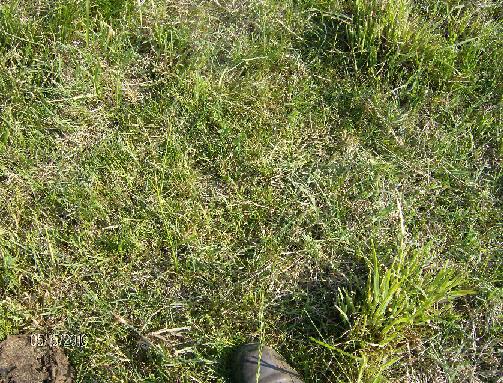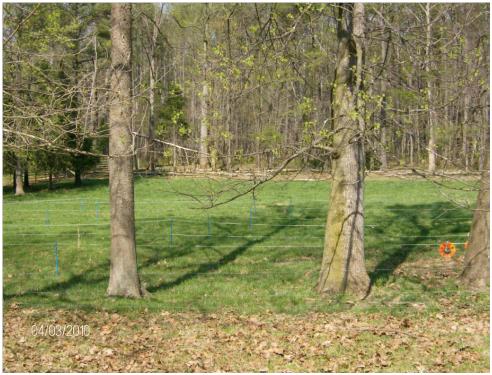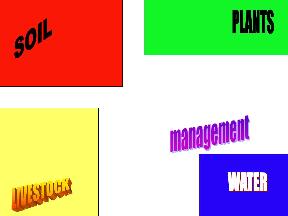Tate’s Tips
A Series of Reflections on growing grass for forage

Issue 6.
Warm Season Grasses
The first few paragraphs should look familiar to those who have followed the series as they are directly from the last article, but a good review.
There are many classifications of plants.
There are annual plants and these are plants that usually grow for a single season or a single crop. Annuals include tomatoes, potatoes and, in fact, most vegetables; corn, wheat, beans and most other commodity crops and forages such as Oats, millet, Crimson clover, sudex, sudan grasses and turnips, canola and other brassicas.
There are a few biannual plants which have a two year life cycle. The most notable of these from a production standpoint would be red clover, a very useful legume. Another would be Canada thistle, a weed.
Then there are longer lived plants which are known as perennials. Their lifespan is determined to a large degree by the growing conditions and management they are exposed to. These would include many of the common pasture and hay grasses such as Orchardgrass, Fescue, Bluegrass, Timothy, Switchgrass, Indiangrass, Bluestem, Bermudagrass, Crabgrass and legumes such as White Clover, Ladino clover and several other clovers, Alflafa, Birdsfoot trefoil and lespedeza.
Some plants like ryegrass have cultivars that are annual and others that are perennial. Crabgrass can come back from the roots but it sets so many seed so quickly, that once you have a good stand it will stay with you for a long time.
Of the plants named above, many were warm season plants and some were cool season plants.
Corn is the ultimate warm season plant. When it is so hot and sticky that you are uncomfortable; corn, given adequate moisture, grows so fast that the growth is almost visible. In the late spring you can measure a day’s corn growth. However any frost will damage corn terribly as it does not tolerate cold weather.
Okay….now we will start fresh.
This year (2010) has made me look like a genius to those who have read the previous articles. Sadly it is just the accumulated wisdom of a lot of bad luck over a lot of years. It is late August 2010 as I address keyboard now.
Everything bad in weather has been dealt to us in spades this year. We had record snow fall in the winter and the wettest winter on record. When spring finally came and it stopped raining, forage producers went to the hayfields this spring, where they found thin stands and reduced yields. We can only surmise that many of the grasses drowned out in the winter and wet spring. Not all farms saw significant decline but many did.
The spring started off like gangbusters otherwise. At first we had what appeared to be the most uniform and potentially best corn crop that I have ever seen in this area. Everywhere I looked corn was beautiful and growing like gangbusters. It was uniform because the wet ground had kept everyone from planting until the ground dried out enough to get equipment on it.
It was beautiful and just about to tassel when the weather changed. Late May it got HOT and it Got DRY. One thing about corn is that it needs moisture when it is in the reproductive stage commonly referred to as tasseling. Corn can stand hot weather but it has to have water. 105 degree days took water away from the soil as if it were being drained. This is the exact opposite of what was needed.
I have been around here a lot of years and I do not recall a year where the corn had no ears. That was the case in a lot of fields this year. Some of the guys say 1977 was as bad. I was in Ohio digging out of snow that year.
When there is not enough water for corn to make ears……..and the weather is hot…..then cool season grasses are in trouble.
Grass weakened by the wet weather and then mown or grazed and then baked for weeks on end…..will mostly be reseeded or overseeded this fall. (We have two no till drills that we rent out for reseeding use.)
The bright spot in many places has been the warm season grasses. At my place, bermudagrass, or common wiregrass, has saved my butt this year. That and the fact that I have been doing Management Intensive grazing has kept me grazing all summer while all around me have been feeding from the short hay supplies harvested in the spring.
The photo below was taken of a daily grazing strip which had just been grazed. The date on the photo is 5/15/2010. The clumps are remnants of cool season grasses and the finer stuff is bermudagrass that was just emerging and spreading to fill in the voids. At that time I was worried about it but now am thankful it did.

The bermudagrass is the only thing I had to regrow after first grazing up until two weeks ago when we finally got a shower or two of rain. My cows and horses have been living on bermudagrass and the occasional sprig of crabgrass since mid early June.
Retired NRCS agronomist Glenn Johnson told me many times that he thought that Eastern Virginia forage producers were missing the boat by not using more Bermuda and crab grasses and overseeding them in the fall with rye and ryegrass. I have perennial ryegrass on my shopping list for this week. Because I know that when frost hits the Bermuda I am out of grass.
Warm season grasses will not stockpile like fescue. Well you can grow a pile of it and leave it out there but when it is frosted it goes dormant and loses feed value rapidly.
The nature of warm season grasses is they are only of value when it is warm. Even warm season grasses need moisture though. the value of warm season grasses is that they grow at a prodigious rate makeing lots of forage in a short time.
I got a phone call from an old friend and a former boss, ( I feel proud of myself to count a former boss as an old friend) who had planted some Teff grass this year and he was bragging on it and sent me some photos. He was waiting for it to quit raining so that he could mow it again.

This photo was taken in southwestern Hanover county in August 2010. The teff was seeded I think he said in June. He has planted some for grazing as well and says Hereford cows love it and it holds up fairly well if given some rest.
Looks like a good leafy forage that he says makes excellent hay of good nutritional quality
My son is farm manager on a good sized farm in Goochland and he addressed the hay shortage by planting two warm season annuals…..brown top millet and sudex. He has baled a section of the millet and got 83 round bales but I do not know the acerage. He is mowing the sudex pictured below today and says it is now ten or twelve feet tall and he is expecting 400 round bales. This is too tall to be optimum but the rain of the last two weeks, and they have had substantial rain over there, has prevented harvest. Even over mature hay is “Better than snowballs” as old Tom Goins used to say to me many years ago.

These are but some examples of warm season grasses and the benefits thereof.
Warm season grasses are grasses that oddly enough grow in warm season of the year. Most do not even begin to be productive until it is nearly hot. They are not drought proof and need water to survive and thrive. They will survive generally with less water than cool season grasses require.
Warm season grasses can be annual or perennial.
Annuals include millets, sorghums, sudexes, sudan grasses, forage peas Johnson grass and some newer stuff like Teff grass.
Perrenials include bermudagrass, crabgrass, switchgrass, bluestem, indiangrass, buffalo grass and others.
Bermuda and Crab are lower growing and both are actually not native to our area. But they are easily grown and have a natural place in forage rotations. Many of our cool season pastures actually have a significant amount of Bermuda and crab in them but they are not noticed as the livestock like them very well. Crabgrass is very palatable to most livestock. Dr. Teutsch is doing significant research on these alternative feeds at the Southern Piedmont Agricultural Research Center.
Further south Bermudagrass is big business. Most varieties are hybrid and are planted by sprigging vegetative cuttings. There is not much sprigging equipment to be found in Va. In the last few years a few seeded varieties of improved Bermudagrass have been developed and are commercially available. There are now improved crab grass seeds available as well. Dr. Teutsch has indicated that some of the local common Bermudas are doing very well in his research.
The others grasses above are termed native grasses and there is a long list of them. They make good forage, require low inputs, are adapted to our area and provide tremendous wildlife benefits, but they cannot stand close or continuous grazing and are more difficult to establish. They are more suited to mechanical forage harvesting, but as large bunch grasses they require a different management than our cool season hay mindset. These forages are also seeing increased used as biomass fuels. Those growers are teaching traditional producers how to manage these ‘new ‘old crops.
Monocultures are not nature’s way. Forage species diversity is good and should be encouraged. As people we have aesthetic landscapes in our minds eye as goals but those goals are difficult and expensive because you have to defeat Mother Nature to get there.
Some of the best graziers in our country value their pastures by the number and diversity of species of grasses that exist in the pasture.
Our new “traditional” “production driven” agriculture has given us the technology to strive toward the desired monocultures. I am not sure we know the true cost.
The older I get the more I see that it is a lot easier to work in concert with mother nature than it is to battle her. I try to approach all things with a mind toward moderation. I strive not to be an extremist in any direction, although some would paint me as the poster child of some extremes. I am currently trying to reduce inputs and increase management and observation. It costs me very little to observe nature at work.
My observation today, is that warm season forages have a place in our systems. We need to embrace them and determine how we can best utilize them in a balanced forage production scheme.
Some excellent reference reading links are below for those who want to learn at a more in depth level as well as the forage seasonality chart. (EVERY Forage grower should know this chart by heart).
The first two are basically the same. One is a web page and the other is a PDF file. I find the PDF file to be more useful.
The third link is to a list of publications by Dr. Chris Teutsch who is Virginia’s current leading authority on forages.
Click to access 418-012.pdf
http://www.pubs.ext.vt.edu/418/418-012/418-012.html
http://www.arec.vaes.vt.edu/southern-piedmont/people/teutsch/index.html
http://pubs.ext.vt.edu/418/418-105/418-105.html

Chart taken from controlled Grazing of Virginia’s pastures



































